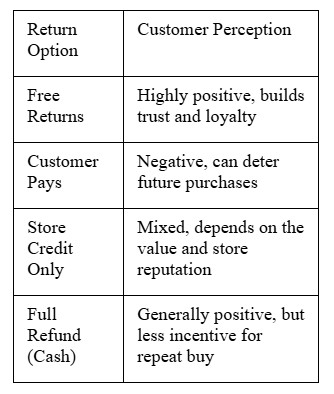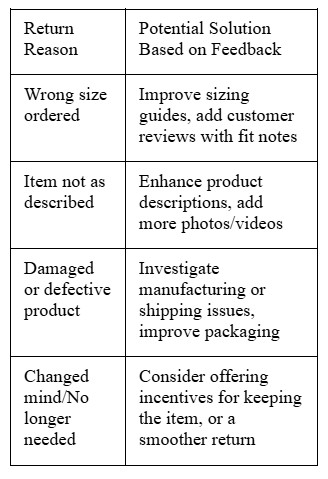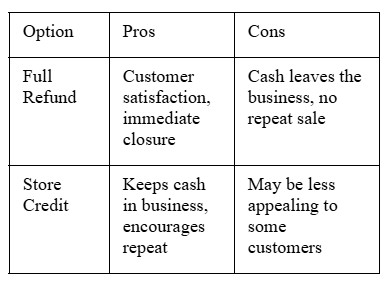Register as an organizer
Click the button below and finish your organizer registration, or fill out the form and we will be in touch to assist you.

So, you're running an online store, and you've probably thought about your return policy. Maybe you see it as just a necessary bit of paperwork, something to get out of the way. But honestly, it's way more than that. It's actually a big deal for your customers, and it can really shape how they see your business. Think about it: people are buying things without actually touching them first. That's a leap of faith, and a good return policy is what makes that leap feel a lot safer. It can be the difference between a one-time buyer and someone who keeps coming back.

So, let's talk about refund policies. It might sound like just a bunch of legal mumbo jumbo, but honestly, it's way more important than most people realize, especially when you're selling things online. Think about it: when you're browsing a website, looking to buy something, what's one of the first things you check? Yep, the return policy. It's like a safety net for your purchase. If you get something and it's not quite right, or you just change your mind, knowing you can send it back without a huge hassle makes a big difference. It really affects whether you click that "buy" button or not.
Basically, a refund policy is just a set of rules that explains how your business handles returns. It spells out what customers can do if they want to send something back, like getting their money back, swapping it for something else, or getting store credit. It covers things like how long they have to return an item, what condition it needs to be in, and who pays for the shipping to send it back. It's the company's official word on what happens when a customer isn't happy with their purchase for whatever reason.
Online shopping has exploded, right? And with that comes a lot more returns. People buy things, try them out at home, and if they don't like them, they send them back. It's become a pretty normal part of the shopping experience. Some studies show that a good chunk of online purchases end up being returned. This isn't necessarily a bad thing for businesses, though. If you handle returns well, it can actually make customers more likely to buy from you in the first place. It’s a big shift from how things used to be, where returning something was a bit of a pain.
Having a clear, easy-to-understand refund policy is super important for a few reasons. First off, it builds trust. When customers know exactly what to expect if they need to return something, they feel more confident buying from you. It also helps avoid confusion and arguments later on. If your policy is vague, you might end up with unhappy customers who feel like you're not being fair. A well-written policy can actually be a selling point, making customers feel safer and more willing to spend their money with you. It's not just about dealing with returns; it's about building a good relationship with your customers from the start.
A good refund policy isn't just about damage control; it's a proactive way to build customer confidence and encourage sales. When people know they can return an item easily if needed, they're more likely to take the plunge and make a purchase in the first place. It removes a significant barrier to entry for many shoppers.
When you're setting up your shop, thinking about how returns will work is super important. It's not just about what you have to do legally, but what makes customers feel good about buying from you. A good policy can actually make people more likely to buy in the first place, knowing they have options if something isn't quite right.
It all starts with being clear. If you say something will get there in 3-5 days, try your best to make it happen, or even sooner. Nobody likes waiting longer than they expected, especially when they've already paid. It’s better to give a slightly longer estimate and beat it than to promise fast delivery and then have delays. That just sets people up for disappointment.
Think about giving customers a decent amount of time to decide if they really want to keep something. While 30 days is pretty standard, many businesses find that offering 60 days or even more can actually lead to fewer returns in the long run. It sounds weird, right? But maybe it gives people time to get used to the item, or they just feel less rushed. It’s like a quiet promise that you stand behind your products.
Paying for return shipping is a big turn off for most shoppers. If you can swing it, offering free returns, maybe with a prepaid label, makes a huge difference. It shows you care about the customer's experience even after the sale. This kind of perk can really make someone choose your store over another, and they're more likely to come back.
Here's a quick look at how different return options might be perceived:

Making the returns process easy and fair is a big part of building a good reputation. It’s not just about the product itself, but the whole experience a customer has with your brand. When things go smoothly, even with a return, people remember that positively.
So, you've got a return policy, which is great. But how do you actually handle all those returned items without it becoming a total headache? It’s all about the nitty-gritty details, the stuff that can make or break a customer's experience, even after they've decided to send something back.
Let's be honest, nobody enjoys paying for shipping, and that feeling gets even worse when it's for a return. If you expect customers to cover the cost of sending an item back, you absolutely must make that crystal clear upfront. Hidden fees are a fast track to unhappy customers and bad reviews. Consider offering a prepaid return label, or at least a discount on future shipping, to soften the blow. It shows you care about their experience, even when they're sending something back.
What state does that returned sweater need to be in for you to accept it? This is super important. You can't just expect items back in perfect, sellable condition if they've clearly been used extensively. Be specific. Words like "unworn," "unwashed," or "in original packaging" are helpful. If you're okay with items being tried on, say that. Setting clear expectations about the condition of returned goods prevents disputes and makes the process smoother for everyone.
Here’s a quick rundown of common conditions:
When an item arrives broken or isn't working right, that's a different ballgame. Your policy should always address this. The best approach is usually to offer a replacement or a full refund, and often, you'll want to cover the return shipping for these items too. Apologize sincerely for the inconvenience and make it right. This is a prime opportunity to turn a negative experience into a positive one and show your customers you stand by your products.
When a product is faulty, the customer's expectation is not just a refund, but a hassle-free resolution. Making this process easy and empathetic can significantly impact their perception of your brand, even if the initial purchase didn't go as planned.
When you're setting up your refund policy, it's not just about what makes sense for your business; you also have to think about the laws in your area and what makes customers happy. It’s a balancing act, for sure.
Different places have different rules about returns. What's okay in one state or country might not fly in another. It’s really important to know these laws so you don’t accidentally get into trouble. You don't want to be caught out because you didn't know you had to accept returns for faulty goods, for example. Staying on the right side of the law here is pretty basic, but it’s easy to overlook if you’re not paying attention.
Nobody likes reading confusing stuff, especially when it comes to getting their money back. If your refund policy sounds like it was written by a lawyer for other lawyers, customers are just going to get frustrated. Try to use simple words. Explain things clearly, like how long they have to return something and what condition it needs to be in. A clear policy makes everyone’s life easier.
Here’s a quick rundown of what to aim for:
Think of your refund policy as a handshake. You want it to be firm and clear, but also welcoming. If it’s too complicated or feels like a trap, people won’t want to do business with you.
Believe it or not, your refund policy can actually help you sell more. When customers know they can return something if it’s not quite right, they feel more confident buying from you in the first place. It’s like a safety net. A good policy can turn a hesitant buyer into a happy customer. It shows you stand behind your products and that you care about their satisfaction. This trust can lead to repeat business and good word of mouth, which is gold for any business.
Your refund policy isn't just a set of rules, it's a living document that should evolve with your customers' needs and your business's growth. Ignoring what your customers are saying about the returns process is a missed opportunity to build trust and improve. Think about it, if you're always asking for product reviews, why not ask about the return experience too?
After a return is processed, a simple follow-up email can go a long way. Ask customers about their experience. Was it easy? Did they get their refund or exchange quickly? Would they shop with you again? This kind of direct feedback is gold. You can even include a quick rating scale for different parts of the process.
Look at the data. Are a lot of people returning the same item? Maybe there's an issue with the product itself, or perhaps the description on your website isn't quite right. If customers are consistently returning items because they ordered the wrong size, it might be time to add more detailed sizing charts or even customer-submitted photos of the product on different body types.
Here’s a quick look at common return reasons and how feedback can help:

Sometimes, the simplest changes based on customer input can prevent future returns altogether. It’s about being proactive, not just reactive.
Based on the feedback you collect and the patterns you see in return data, make adjustments to your policy. If many customers mention that paying for return shipping is a barrier, you might consider offering free returns, at least for a trial period. Showing customers you're listening and willing to adapt builds loyalty. If a significant number of returns are due to confusion about your policy, it’s time to rewrite it in clearer, simpler terms. Your refund policy should be a tool that helps customers, not a hurdle they have to jump over.

Thinking about your refund policy isn't just about appeasing customers; it really hits your bottom line. It’s a balancing act, for sure. You want to be fair and keep people happy, but you also don't want to bleed money. Let's break down how your policy choices can affect your finances.
When a customer wants to return something, you have a choice: give them their money back or offer store credit. Most people will grab the cash, but there are ways to make store credit more appealing. You could offer a little extra if they choose credit, maybe 10% more than the original purchase price. Or, you could sweeten the deal by covering return shipping only if they opt for store credit. This keeps the money circulating within your business and encourages repeat purchases.
Here's a quick look at the trade offs:

Making store credit a good option is smart business. It’s not just about holding onto cash; it’s about bringing customers back. If someone returns an item but gets store credit, they’re more likely to come back and buy something else. Think about it, if they liked your stuff enough to buy it the first time, they might find something else they love with that credit. It’s a way to turn a return into a future sale.
It might seem counterintuitive, but being a bit more flexible with returns can actually pay off in the long run. A study found that when businesses offered longer return periods, customers were actually less likely to return items. It’s weird, right? Maybe having more time just makes people get used to the product, or they feel less pressure to decide immediately. Plus, a good refund policy builds trust. When customers know they can return something without a hassle, they feel more comfortable buying from you in the first place. This loyalty can lead to more sales over time, even if you have a few more returns here and there. It’s about building a relationship, not just making a single sale.
A well-thought-out refund policy isn't just a cost center; it's a tool for customer retention and building brand trust. It can influence purchasing decisions and, when managed correctly, contribute positively to your overall financial health by encouraging repeat business and customer loyalty.
Look, making a return policy easy to understand and fair isn't just about following the rules. It's a smart move for any business. When customers know they can send something back without a hassle, they feel more confident buying from you in the first place. Plus, a good return process can actually turn a potentially bad experience into a good one, making customers more likely to shop with you again. So, don't just slap something together; think about what makes sense for your customers and your business. It might just be one of the best decisions you make.
A return policy is like a set of rules that explains how customers can send back items they bought. It tells you what you can return, how long you have to return it, and what you'll get back, like money or a different item.
It's super important because it helps customers feel safe buying from you. If they know they can easily return something if it's not right, they're more likely to buy it in the first place. It also helps you avoid problems and keeps customers happy.
Things like how long customers have to return an item, if you'll pay for return shipping, and what condition the item needs to be in to be returned. Being clear about these things makes customers happier.
Many online stores let you return items for free. This makes customers feel like they have nothing to lose by buying from you. It's a great way to keep them coming back.
Yes, you should! When customers return items, ask them why. This feedback helps you fix any issues with your products or how you describe them, which can lead to fewer returns in the future.
It's best to keep your policy simple and easy to understand. Avoid using confusing legal words. Just explain clearly how returns work so everyone knows what to expect.
More blogs
Click the button below and finish your organizer registration, or fill out the form and we will be in touch to assist you.